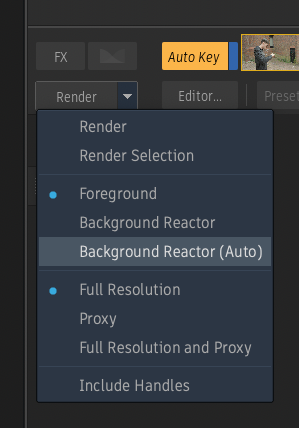Rendering
When working in Batch, Batch FX, or the Timeline, you can get instant feedback when viewing and playing back clips without the need to render. To output your clips, however, you do need to render. In many areas of Flame, rendering is straightforward by using the Render box, or contextual rendering options. In most cases, rendering clips and sequences from the Workspace only renders the required effects and transitions (and not all effects and transitions located on multiple video tracks).
When you use Burn or Background Reactor to render, some situations will interrupt or outright cancel a background render job:
- Modifying a segment: If you modify a segment, any background job that already exists for that segment is cancelled. This saves the GPU from processing content that is no longer current.
- Deleting an FX: If you delete a Timeline FX being rendered in the background, that background task does continue. This protects the Undo stack, making sure that if you undo the deletion of the Timeline FX you do get back the Timeline FX and its cached media.
- Playback: During playback, background tasks (caching, media export, Burn and Background Reactor) are paused to protect real-time playback. You can force background jobs to execute during playback by disabling Protect Playback in the General Preferences, under the Background Tasks section.
Rendering Preferences
In the Preferences panel, there are a few options to help you set default rendering settings. See General Preferences for more information.
Background Reactor
Background Reactor is a background rendering service. Using Background Reactor allows you to continue working while effects are being rendered on the same workstation Flame is running on. It can be used in dual-GPU (Rocky Linux only) or single-GPU (Rocky Linux and macOS) configurations.
Each environment (Conform, Timeline, Effects, and BFX) has its own rendering setting (foreground or background). The default Rendering mode (Foreground, Burn, or Background Reactor) is defined in the General Preferences, under the Default Rendering Options section.
Do not worry about Background Reactor monopolizing your system resources. Background Reactor only starts when you set the Render menu to Background Reactor (Auto or not). And if you exit Flame while Background Reactor is still processing jobs, Background Reactor will only shut down once all relevant tasks are completed.
Background Reactor requires specific hardware on Rocky Linux, listed on the system requirements page.
For information on how configure Background Reactor, see the Background Reactor.

Automatic Background Rendering
When in the Conform, Timeline, and Effects environments, Flame can automatically render Transitions and Timeline FX in the background.
To enable automatic background rendering, select Background Reactor (Auto) from the Render drop-down button.

With Background Reactor (Auto) selected, the text of the Render button changes from white to blue.
 |
Click Reactor to send the whole sequence to background rendering. |
 |
Click Reactor Sel to send only the selected segments to background rendering. |
With Background Reactor (Auto) enabled, a segment automatically starts rendering in the background when:
- You scrub the positioner away.
- You unselect the segment.
Burn
Burn allows you to render images in the background using low-cost Linux workstations, freeing your workstation for more creative tasks. With Burn, facilities can leverage a larger pool of rendering power so that complex visual effects requiring intensive processing can be created more quickly. See the Rendering on Networked Hardware section of the Installation and Configuration Guide for more information on how to install, license, and configure Burn to work with Flame.
About Automatically Disabled HWAA
In order to increase performance when in interactive mode, the hardware anti-aliasing (HWAA) level in interactive mode gets automatically disabled whenever the graphics card doesn't have enough memory. This can happen in Text, GMask, and Action modules.
Whenever the graphics card has to swap some of the textures to disk in order to allocate memory for a large HWAA buffer, the responsiveness of the system is affected. To increase the reactivity of the interactive mode, Flame disables the HWAA whenever this happens. The availability of HWAA in interactive mode depends two on factors: the amount of graphics memory available when the HWAA level is set, and on the resolution of the monitor where the user interface is displayed.
Static Frame Pipeline Optimization
Rendering media can be time-consuming, and depends on a number of factors, including the type of media and the effects applied to it. Static frame pipeline optimization can significantly decrease rendering times for sequences or Batch or Batch FX schematics that use static source generators (such as the Coloured Frame Node, for example), static media (stills), and static effects. A static effect is one that is not animated over time, such as static Text or a static GMask. When rendering static media, the result of a static source generator or a static effect, Flame renders and caches a single static frame, and uses that frame for the duration of the static element, rather than rendering each individual frame. This enables noticeably shorter rendering times.
